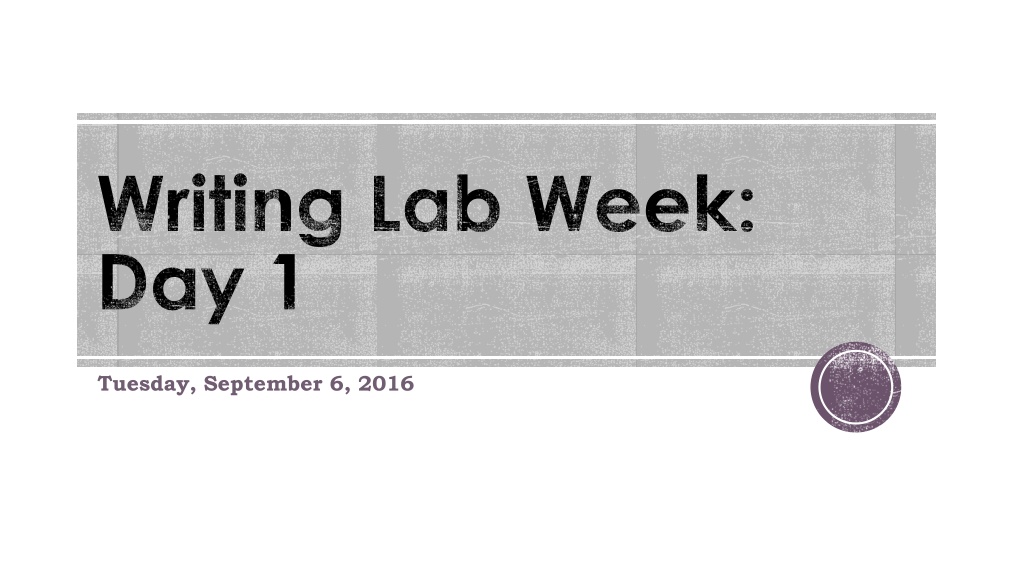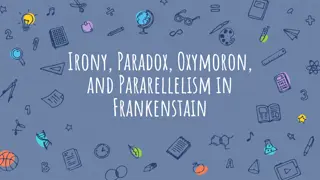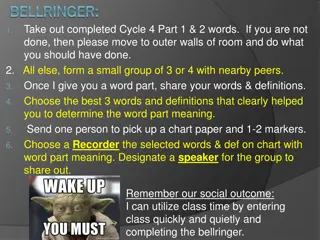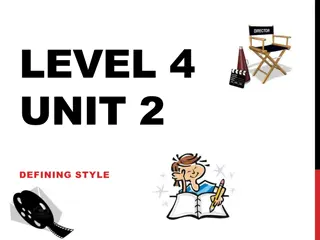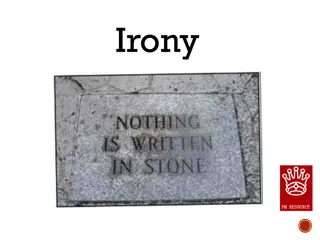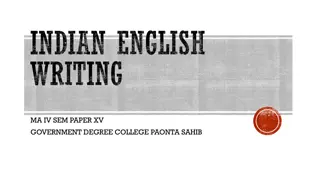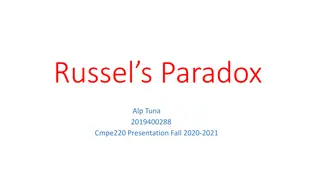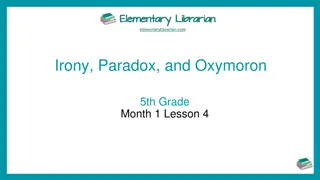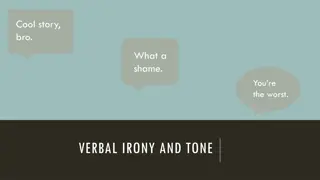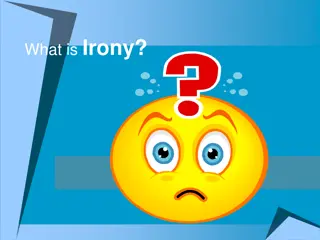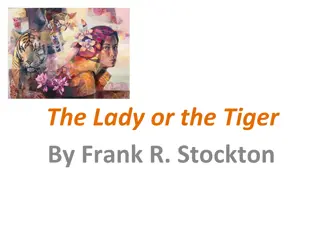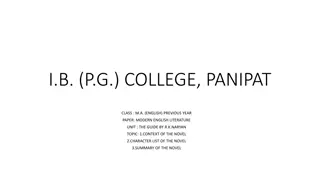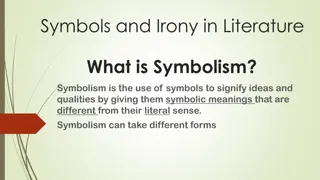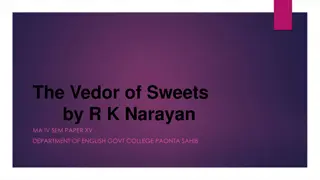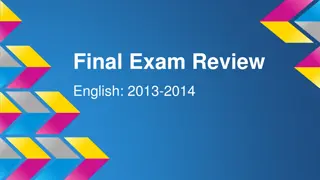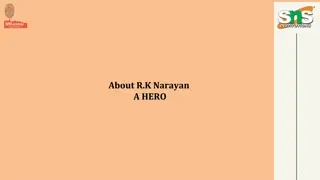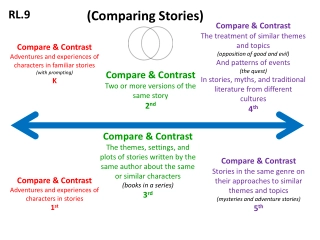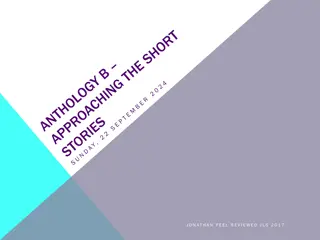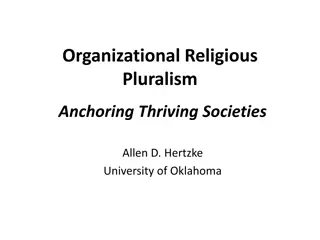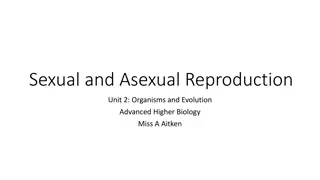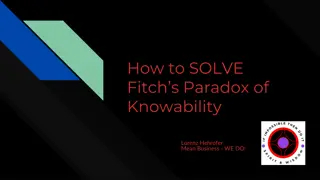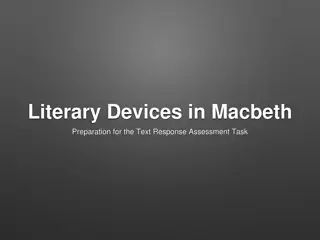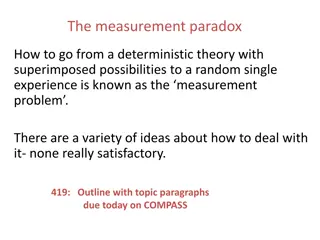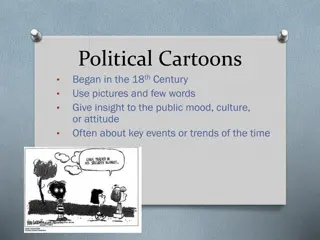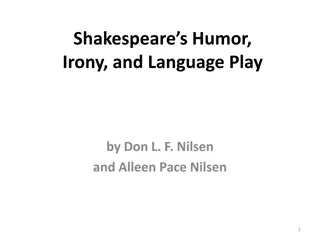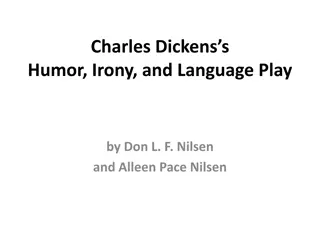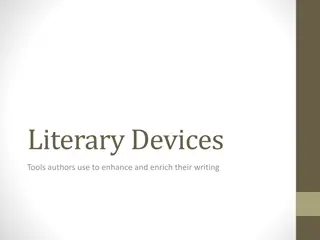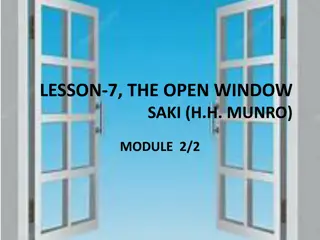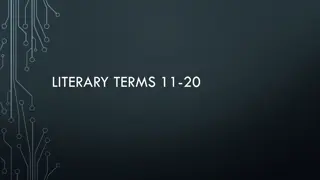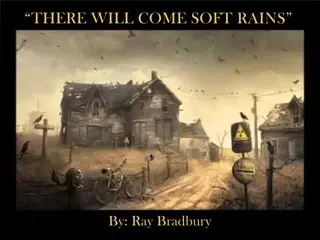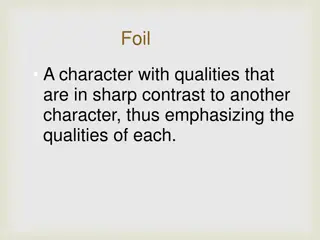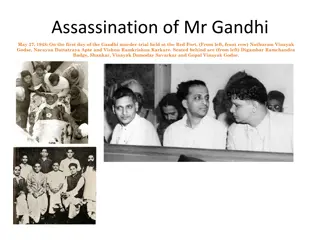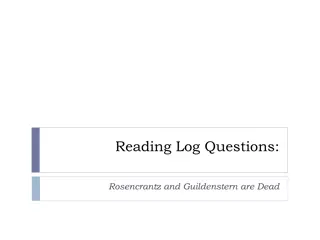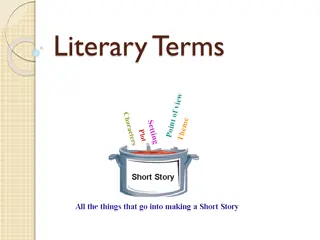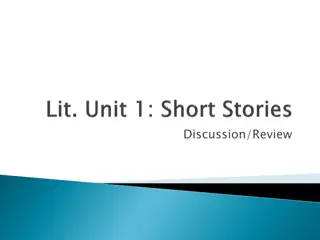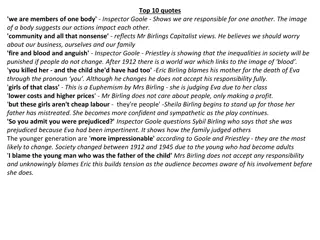Analysis of Irony and Paradox in Narayan and Saki's Stories
Explore the use of irony and paradox in the works of R.K. Narayan and Saki to highlight the themes of truth, deception, and honesty. Compare and contrast how the authors present these concepts, providing evidence from the texts to support your analysis. Identify examples of dramatic, situational, and verbal irony, as well as paradoxes, to understand the deeper layers of meaning in the stories.
Download Presentation

Please find below an Image/Link to download the presentation.
The content on the website is provided AS IS for your information and personal use only. It may not be sold, licensed, or shared on other websites without obtaining consent from the author. Download presentation by click this link. If you encounter any issues during the download, it is possible that the publisher has removed the file from their server.
E N D
Presentation Transcript
Writing Lab Week: Day 1 Tuesday, September 6, 2016
Write a bullet point summary of Like the Sun by R. K. Narayan. Write for fifteen minutes. You should have at least 8-10 sentences/points. Use characters names and details. Note: I will not stamp your work if you do not include the above requirements. If you want to be better writers, it starts today with hard work and FOCUS. BELLWORK 9/6/16 Name, Period Number, Date!
Start with the Prompt! What is the question asking you to do? Writing the introduction with a clear, meaningful thesis statement will create a map of where your paper will take me.
Here is the prompt. . . With your group, write down and highlight the key components of what you must answer. Both Narayan and Saki use irony or paradox to explain ideas. In an essay, compare and contrast how the authors present the concepts of truth and deception in these stories. Provide evidence from the text to support your understanding. 1.Identify a few examples of irony or paradox in each story. 2.Draw a conclusion about the message each writer is expressing about truth, deception, and honesty. 3.Take notes on how the use of irony and paradox help each writer express his message. Find quotations from the text that you can include to support your ideas.
What did your group highlight? Both Narayan and Saki use irony or paradox to explain ideas. In an essay, compare and contrast how the authors present the concepts of truth and deception in these stories. Provide evidence from the text to support your understanding. 1. Identify a few examples of irony or paradox in each story. 2. Draw a conclusion about the message each writer is expressing about truth, deception, and honesty. 3. Take notes on how the use of irony and paradox help each writer express his message. Find quotations from the text that you can include to support your ideas.
What is the question asking you to do? Compare and contrast how the authors present the concepts of truth and deception in these stories.
What is the question asking you to do? Identify and write down three examples of irony or paradox in the stories. Dramatic Irony A plot device to create situations where the reader knows much more about the episodes and the resolutions before the chief character or characters. Situational Irony Situational irony occurs when the final outcome is contradictory to what was expected. Verbal Irony Verbal irony occurs when speakers say the opposite of what they mean. Paradox A concept that seems absurd or contradictory, yet is true. The uniqueness of paradoxes lies in the fact that a deeper level of meaning and significance is not revealed at first glace, but when it does crystallize, it provides astonishing insight.
What is the question asking you to do? Identify a few examples of irony or paradox in each story. Like the Sun by R. K. Narayan Paradox: Truth, Sekhar reflected, is like the sun. I suppose no human being can ever look it straight in the face without blinking or being dazed (191). Narayan is suggesting that truth hurts sometimes, and even if we ask for it and believe we want to hear it, we react negatively with hurt feelings. The Open Window by Saki Irony: Mr. Nuttel is prescribed rest and relaxation in the countryside by his doctor. His nerves are completely shot, and the niece of the estate, knowing of Mr. Nuttel s ignorance of the family, fabricates a story about the tragic death of her aunt s husband, two brothers, and favorite hunting dog. When the hunting party returns to the window left open for them, Mr. Nuttel runs in complete horror believing he had witnessed the return of ghosts. The irony is that the peaceful countryside was exactly the opposite of what his doctor had ordered.
What is the question asking you to do? With your group, identify one more example of irony or paradox from each story. Like the Sun by R. K. Narayan Example: Is it irony or paradox? The Open Window by Saki Example: Is it irony or paradox?
What is the question asking you to do? Draw a conclusion about the message each writer is expressing about truth, deception, and honesty. Like the Sun by R. K. Narayan The author is saying The Open Window by Saki The author is saying
Writing Lab Week: Day 2 Wednesday, September 7, 2016
Write a bullet point summary of The Open Window by Saki. Write for fifteen minutes. You should have at least 8-10 sentences/points. Use characters names and details. Note: I will not stamp your work if you do not include the above requirements. If you want to be better writers, it starts today with hard work and FOCUS. BELLWORK 9/7/16 Name, Period Number, Date!
Lets look at the authors messages that we wrote down yesterday Draw a conclusion about the message each writer is expressing about truth, deception, and honesty. Like the Sun by R. K. Narayan The author is saying The Open Window by Saki The author is saying
What is the question asking you to do? Draw a conclusion about the message each writer is expressing about truth, deception, and honesty. Like the Sun by R. K. Narayan Narayan believes that truth can set us free and teach us valuable lessons, like not wasting money on music lessons. Life is best-lived when a person is honest. The Open Window by Saki In a much less serious tone, Saki celebrates the inherent creativity and humor that exists in deception through Vera s tale telling. Not only does she make up a story that completely fools a grown man, but she also avoids potential punishment for the lie by fabricating the story of Mr. Nuttel s fear of dogs so that her aunt will not wonder why he left so abruptly. The teenager appears clever and the audience finds her antics humorous and charming.
Using this information, write a thesis statement addressing the writing prompt: In an essay, compare and contrast how Narayan and Saki present the concepts of truth and deception in Like the Sun and The Open Window.
Lets take a look at the thesis statements and provide feedback
Sample thesis statement that I developed Narayan believes that truth can set us free and teach us valuable lessons, while in a much less serious tone, Saki celebrates the inherent creativity and humor in deception.
Open with something that will draw readers in. Sometimes, especially if the topic of your paper is somewhat dry or technical, opening with something catchy can help. The Introduction
Your introduction is an important road map for the rest of your paper. Your introduction conveys a lot of information to your readers. You can let them know what your topic is, why it is important, and how you plan to proceed with your discussion. In most academic disciplines, your introduction should contain a thesis that will assert your main argument. It should also, ideally, give the reader a sense of the kinds of information you will use to make that argument and the general organization of the paragraphs and pages that will follow. The Introduction
Consider these options: an intriguing example a provocative quotation that is closely related to your argument a puzzling scenario a vivid and perhaps unexpected anecdote a thought-provoking question Think of your introductory paragraph in the shape of a funnel, moving from the general background to the more specific purpose of the paper.
Introduction: An Old English proverb teaches us that Honesty is the best policy, but is that truly the case? In the short stories Like the Sun by R. K. Narayan and The Open Window by Saki, the authors explore the concepts of truth and deception through the use of irony and paradox. In the end, what they reveal is that the proverb may not actually be worth following. Ultimately, the truth causes more harm than good for Sekhar, and Vera s deception entertains us by allowing us to recognize that Mr. Nuttel takes himself much too seriously. Narayan believes that truth can set us free and teach us valuable lessons, while in a much less serious tone, Saki celebrates the inherent creativity and humor in deception.
Planning the paper Use the order you have established in your thesis statement. For example, my thesis mentions the Native Americans, then the Puritans, and finally, a comparison of the two. Therefore my paper will look like this: I. Introduction II. Paragraph analyzing Narayan s Like the Sun. III. Paragraph analyzing Saki s The Open Window. IV. A comparison of the two what common ground they shared. V. Conclusion
Using your revised thesis statement, work with your group to plan your paper: I. II. III. IV. V.
Find quotations from the text that you can include to support your ideas. Paragraph 2 Paragraph 3 Like the Sun by R. K. Narayan Quotations: We must give and take absolute Truth whatever may happen. Otherwise life is not worth living (191). When Sekhar learns that he will have to grade all 100 paper in one night due to his commitment to the truth, Narayan writes, Yes, sir, feeling that sitting up all night with a hundred test papers was a small price to pay for the luxury of practicing Truth (194). The Open Window by Saki Quotations: Then you know practically nothing about my aunt? pursued the self- possessed young lady . . . Her great tragedy happened just three years ago, said the child, that would be since your sister s time (196). Her description implies the author s admiration. I expect it was the spaniel, said the niece calmly; He told me he had a horror of dogs. He was once hunted . . . by a pack of pariah dogs (198).
Find examples from the text that you can include to support your ideas. Additional info for Paragraphs 2-3: The Contrast Differences at a glance Paragraph 4: The Comparison Similarities at a glance Both stories involve an internal conflict of choosing to tell a truth or a lie. Tone: Narayan is serious and contemplative, whereas Saki is witty and light-hearted. The reader feels empathy for the headmaster and the wife for having to hear the brutal truth, and perhaps experiences the same when Mr. Nuttel is humiliated by being so gullible. Purpose: Like the Sun is philosophical in nature, while The Open Window is purely entertaining.
Add the textual evidence and examples you would use for each paragraph II. III. IV.
Writing Lab Week: Day 3 Thursday, September 8, 2016
Its 50 years in the future, and the world is at war. Luckily, when the nuclear bombs dropped, you had a bomb shelter under your house to hide out in. When your monitors tell you it s safe to go outside a year later, what do you find? Who or what is still alive? Write for ten minutes. You should have at least a full paragraph of 6-8 sentences. BELLWORK 9/8/16 Name, Period Number, Date!
Return to the theme or themes in the introduction. This strategy brings the reader full circle. For example, if you begin by describing a scenario, you can end with the same scenario as proof that your essay is helpful in creating a new understanding. You may also refer to the introductory paragraph by using key words or parallel concepts and images that you also used in the introduction. The Conclusion
Synthesize, dont summarize: Include a brief summary of the paper s main points, but don t simply repeat things that were in your paper. Instead, show your reader how the points you made and the support and examples you used fit together. Pull it all together. The Conclusion
Beginning with an unnecessary, overused phrase such as in conclusion, in summary, or in closing. Introducing a new idea or subtopic in your conclusion. Making sentimental, emotional appeals that are out of character with the rest of an analytical paper. The Conclusion: Strategies to Avoid!
Work Time! Use the remainder of class time to work on your rough draft. You have a thesis statement, an outline for the paper, and quotations to use as evidence to support your claims. Have something ready to type tomorrow!
Your heading goes in the upper LEFT hand corner: Your Name Ms. Ousley English 10 Date REMINDER!
Writing Lab Week: Day 4 Friday, September 9, 2016
Both Narayan and Saki use irony or paradox to explain ideas. In an essay, compare and contrast how the authors present the concepts of truth and deception in these stories. Draw a conclusion about the message each writer is expressing about truth, deception, and honesty. Provide evidence from the text to support your understanding. Your essay should contain a strong thesis statement and at least three body paragraphs with evidence to support your opinion. Each body paragraph should have at least one quotation from Like the Sun or The Open Window. In all, you will have five paragraphs: an introduction, three body paragraphs, and a conclusion. Submit a hard copy before you leave class. I will meet you at the door. Computer Lab Time
